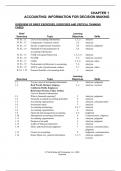Exam (elaborations)
Solutions manual Accounting Information For Decision Making (Financial & Managerial Accounting William et al.) || All Chapters A+
- Course
- Institution
Solutions manual Accounting Information For Decision Making (Financial & Managerial Accounting William et al.) || All Chapters A+
[Show more]



